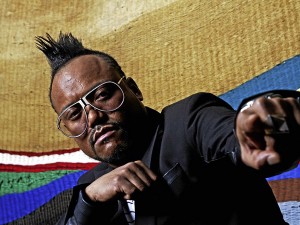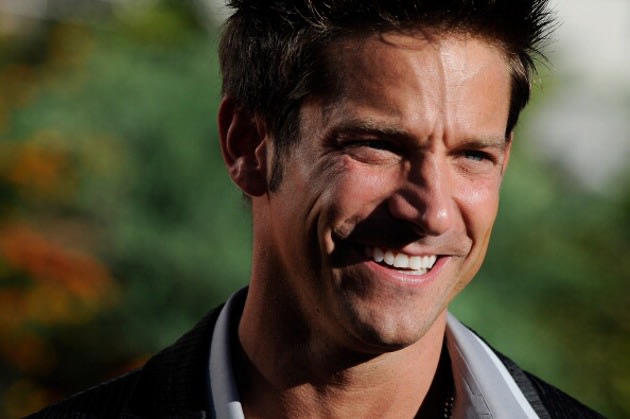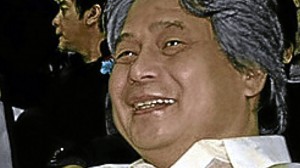Eric S. Caruncho
 You can go home again.
You can go home again.
With his trademark Mohawk hairdo, and pimped out in an all black outfit and black, knee-high biker boots, Black Eyed Pea apl.de.ap a.k.a. Allan Pineda Lindo Jr. stands out in a sea of white barongs.
The cream of corporate Makati, mostly bank executives and their staff, have gathered together in a Legaspi Village penthouse ballroom to honor Apl who has been chosen one of the Bank of the Philippine Islands’ BPInoy awardees for 2011.
The annual accolade goes to Filipinos who have done their country proud in the international arena. apl has been chosen not only because of his membership in the Black Eyed Peas, a massive global pop franchise that has sold more than 56 million albums worldwide, but also because for the last few years, he has been coming home to the Philippines to give some of his blessings back to the land of his birth.
At first it was just an annual Christmas homecoming that saw apl giving out gift packages to the less fortunate residents of his hometown in Angeles City, Pampanga.

BIG APL: As BPInoy awardee (Inquirer Photo/Alanah Torralba)
The last couple of years, however, apl has made it more formal by establishing the apl.de.ap Foundation to serve as the vehicle for his humanitarian efforts.
Last August, he donated a computer lab and library to his old school, the Sapang Bato National High School in Pampanga. He also built a music studio at the Holy Angel University, also in Angeles City, where young Filipinos can hone their talents.
But apl has set his sights beyond his hometown: he plans to take his mission nationwide. In partnership with the Ninoy and Cory Aquino Foundation, which has appointed him a “special ambassador for education,” he has chosen to focus his efforts on an education advocacy campaign called “We Can Be Anything.” It is a perfect fit for the man who once said: “dreaming big and doing something about it can get you really far.”
To help drive the message home, apl composed and recorded the single “We Can Be Anything,” complete with inspirational music video.
“I think that with an education, you can be anything,” he says. “You could be a musician, you could be an artist, but with an education you always have a background to fall back on. It’s really important for me to give the youth an equal opportunity. I want Filipino kids to compete around the world, with technology and computers and stuff.”

He plans to continue building more computer labs and music studios.
“I want talented kids that are into music to have an outlet, to have a place to go to and record demos, and practice,” says apl. “In the future I want to be able to discover talents from the Philippines, and that’s why it’s important for me to provide technology and music studios and library. You never know, I might find the next Black Eyed Peas.”
He has also pledged to help in building 10,000 new classrooms in the next two years, to help the Department of Education put a dent in the estimated shortfall of 68,000 classrooms throughout the country. Among other things, he has been using his celebrity status to raise funds abroad for this purpose through various charities.
“I’ve also been talking to companies in the US like Google,” he says. “There’s a Filipino team in Google who are planning to teach kids computer science and technology via the Internet. Now that we’ve build these computer labs, we have to teach the teachers how to teach kids to work with these computers.”
Despite the Christmas rush, apl also took time out to visit calamity-stricken Cagayan de Oro, and to spend time in La Huerta, the underprivileged community in Parañaque where the video for “We Can Be Anything” was shot.
Like other celebrities who are driven to give back, he seems to be motivated by a deep sense of gratitude for the opportunities he has been given, and the realization that things could very easily have turned out differently.
Sapang Bato, where Allan Pineda Lindo Jr. was born on November 28, 1974, lies on the hilly outskirts of Angeles City, near Clark Air Base. His biological father, a black American airman, abandoned the family right after Allan was born, leaving his mother Cristina Pineda to support him and six other siblings.

“We were poor, but my mom is like a superwoman—she’s just a great entrepreneur,” apl recalls. “We used to have a store in front of the house, and she was great with turning money around.
Nevertheless, life was hard, and as the eldest, apl had to help feed the family from a young age.
“I remember when I was around 10 years old, I would go with my grandfather to the mountains to farm.
Marunong akong magtanim ng mais, ng kamoteng kahoy (I know how to plant corn and cassava). He taught me how to ride the kalabaw, and I know how to araro (to plough). And how to make charcoal. I used to have to deliver the crops to the palengke at around 3 a.m.”
It was hard work, especially for a 10-year-old, but apl had imbibed the traditional Filipino family value that the eldest son had to share some of the responsibility for supporting the household.
“I used to like doing it,” he says. “Being the panganay, I was just willing to help my grandpa and stuff.”
To make things even more difficult, he had been born with nystagmus, a condition that causes involuntary eye movements and which leads to impaired vision. Although he was a good student, apl sometimes had to sit in front to be able to read the blackboard, or copy his seatmates’ notes.
“It was pretty hard, but I’ve learned how to adapt to my surroundings,” says apl, who is considered legally blind because of his affliction. “When I was young I didn’t know how to control it, but since I’ve grown up I’ve learned to conquer it, I guess. It’s weird, sometimes I feel like I have selective sight, ’cause I’m very good at basketball, none of my friends can beat me in bowling, none of them can beat me in pool, I can break-dance, and pretty much do everything. I just can’t drive.”
Being a “G.I. baby,” apl was eligible for assistance from the Pearl S. Buck Foundation, a US-based NGO founded by the author of “The Good Earth” and dedicated to helping Amerasian children.
Through the Pearl S. Buck Foundation, the young boy found a sponsor in Joe Ben Hudgens, a children’s rights attorney, who sent money for tuition and school supplies. Eventually, his mother arranged for Hudgens to legally adopt her son.
apl had mixed feelings about being adopted: he was grateful for the opportunities that being in the US opened up for him, but he was also homesick and missed his family.
“When I first got adopted and brought to the US, I would write home, and sometimes I’d get my allowance and put it in the letter. Sometimes it wouldn’t make it, so what I started doing was, every dollar I had I would write down the serial number in the letter, so at least if somebody took it, they would know that I tried to send some money back.”
Still, going from Angeles, Pampanga to Los Angeles, California was a culture shock for the 14-year-old boy.
“I remember when I first got to the US, there were a lot of gangs—Filipinos fighting other Filipinos. It didn’t make sense to me. I met a Filipino friend who used to dance, and he had a certain attire—long polo shirt, black pants and Vans, and I thought that was a dancer’s attire. But when I tried to dress like him, I was chased home by other Filipinos. I guess it was a gangster’s attire.
Music proved to be his salvation. Back in Angeles, the year before he left for the States, he had gotten into break dancing after seeing youngsters at school doing the old school popping and locking moves.
“I didn’t come to the US to be a gangster, so I changed my whole attire and focused on break dancing and making music, and I became neutral with everybody. I could hang out with the gangsters, I could hang out with the Fil-Ams, I could hang out with what they called the FOBs—fresh off the boat—because I was into music. Music gave me that positive outlook instead of (me) getting caught up in gangs and fighting other Filipinos. That wasn’t my purpose. My purpose was to make it so I could help my family.”
apl also found a kindred spirit in future Black Eyed Pea William Adams, a.k.a. will.i.am—a nephew of his adoptive father’s roommate.
“My dad needed a babysitter for me, and Will’s uncle suggested Will’s mom Deborah. They took me to Will’s house, and Deborah made Will stay home from school to hang out with the kid from the Philippines.
He said, ‘So what do you guys do in the Philippines?’ and I said ‘I like to break-dance, I just learned this new move called the running man that I saw in a Pepsi commercial’ and he said ‘I dance too.’ We just started having conversations and the rest is history. We became best friends.”
William lived in East LA, in the ghetto, and apl liked hanging out there, perhaps because it reminded him of home. In any case, the pair got deeper and deeper into music, eventually forming a group called Tribal Nation, which later evolved into A Tribe Beyond A Nation or ATBAN.
“We would go to a lot of Filipino house parties in Glendale and West Covina and the Valley, and we would just start free-styling. From dancing we started rapping. And we wanted to learn, ‘where’s this music that we’re dancing to from,’ so we started researching that, and we got into producing and making beats and composing songs.”
Even in the eighth grade, apl already had that drive to make it.
“I made sure I surrounded myself with good friends, with the same values. My whole purpose in being adopted and going to the US was for my family, so I never strayed from that. I gotta make it. I gotta pursue my dreams and be able to go back home to help my family—that was always in the back of my mind whatever I went through.”
It was a struggle, specially in the early days when hip hop was dominated by gangster rap and the whole East Coast vs. West Coast rivalry. Music business types didn’t know what to make of the multicultural stew that would become the Black Eyed Peas.
“I was influenced by groups like A Tribe Called Quest, De la Soul, the Jungle Brothers, Boogie Down Productions. I gravitated more toward the old school and break dancing, and that’s really influenced how we wrote, because the way they made music was more for fun instead of killing and slapping girls, and ‘I got all this money.’ It was more about the art and the movement of hip hop and that’s why I think our music was positive. We didn’t have it in us to be gangsters.”
In a sea of bitch this and ‘ho that, apl’s music was actually a breath of fresh air. But it would take time for the industry to catch up.
“It didn’t come overnight,” he recalls. “It was hard to get signed by a record company because we weren’t gangsters and we were so different. We had to prove ourselves—we would play at clubs, colleges, and what we would do was we would have a notebook with a mailing list, and we would call these people for the next show. We had to actually create a following, and prove to the record companies that there is a market for that kind of music. We would do shows for 5,000 people, and we had to prove to the record labels that there is room for eclectic and more progressive type of music.”
Finally, apl and Adams got themselves signed in 1992. Three years later, after Jaime Gomez a.k.a. Taboo joined, they changed their name to the Black Eyed Pods, and then the Black Eyed Peas. Their first two albums—“Behind the Front” (1998) and “Bridging the Gap” (2000) garnered critical acclaim, but after Stacy Ferguson a.k.a. Fergie joined in 2003, and the band released their third album “Elephunk,” critical mass was finally achieved, and the multi-platinum pop phenomenon that we know today as the Black Eyed Peas assumed its present form.
But apl’s elation at his band’s finally achieving success after years of struggle was tinged with personal tragedy. Back home in Sapang Bato, his troubled brother Arnel had taken his own life.
“That was a dark period in my life,” he recalls. “He had certain personal vices, and he suffered from depression. I’m pretty sure he felt bad inside and couldn’t take it anymore. I felt like if I had been there as a big brother, I could have stopped him. Sometimes life just gets you down, and I wish he had somebody to run to.
These mixed emotions inspired apl to write what eventually became “The Apl Song” on “Elephunk.”
“I was in the studio experimenting with sampling, and I remembered that my mom used to listen to Asin all the time,” he says. “That was the same time when my brother passed away, and I wanted to dedicate a song to him, and also tell my life story, and that chorus from [the] Asin [song ‘Balita’] just really touched how I was feeling, and I just kind of did it. Will came over to the studio and I played it for him, and he said ‘That’s pretty dope, you should put that in the album yo.’ Really? But it’s in Tagalog—people wouldn’t understand. But he said, it’s not about understanding it, it’s about the feeling. You’re sharing your musical culture.”
The band’s wholehearted support strengthened apl’s inclinations to represent where he was from in his music. While it wasn’t the worldwide hit that “Where Is The Love” was, “The Apl Song” endeared the Black Eyed Peas even more to their Filipino fans, and even gave the reunited Asin a boost for a time.
Even as the Black Eyed Peas’ star continued to rise, tragedy continued to dog apl. In 2009, he lost another brother, Joven, this time to murder.
All of this darkness in his personal life only seemed to underscore how blessed Pineda has been, and has only strengthened his desire to share the fruits of his success with his countrymen. Now that the Black Eyed Peas are on a hiatus, apl’s advocacy work has gone to the forefront.
“I’m going to focus on ‘We Can Be Anything,’” he reiterates. “We’ve got two years to build 10,000 classrooms and I’m going to focus on that. I’m also going to build my next computer lab from the apl Foundation.”
Also in the works is apl’s long-awaited solo project.
“It’s going to be more personal,” he says. “I’m gonna try to write more Tagalog songs. I’m Kapampangan so I wanna write a Kapampangan song in there. I like a lot of different music genres from dance music to drum and bass, so I’m going to mix it all up.
The solo project will likely reveal more of Apl’s Filipino roots
“I’m still into the classics. I love listening to Asin, Freddie Aguilar, Florante. I like Gloc 9—big fan. Also Bamboo, Slapshock. Oh and I’ve just been researching Tito, Vic and Joey’s old stuff, all their dance disco stuff with VST and Co. I want to collaborate with them. I want to remix their song—I think it’s called ‘Magsayawan Tayo.’”
When he’s not performing with the Black Eyed Peas, apl is also a much-sought after DJ.
“My DJ career is getting bigger now,” he says. “I’m apl.de.ap a.k.a. the Party Man. I like to DJ around the world and play at festivals. I like going out to clubs and experiencing new types of music. I think that’s how you stay fresh and how you can be current on what’s going on in the music world.”
But for all his globe-trotting, home for apl will always be here.
“I’m made in the Philippines all the way,” he says proudly. “I grew up here until I was 14, and I could never change that. It’s just a certain feeling. When I’m here I feel at home.”












